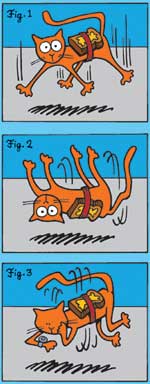|
|
The buttered cat paradox is a joke paradox based on the tongue-in-cheek combination of two adages: * Cats always land on their feet. * Buttered toast always lands buttered side down. The paradox arises when one considers what would happen if one attached a piece of buttered toast (butter side up) to the back of a cat, then dropped the cat from a large height. Thought experiments Some people jokingly maintain that the experiment will produce an anti-gravity effect. They propose that as the cat falls towards the ground, it will slow down and start to rotate, eventually reaching a steady state of hovering a short distance from the ground while rotating at high speed as both the buttered side of the toast and the cat’s feet attempt to land on the ground.[1] This, however, would require the energy that keeps them rotating to come from the gravitational energy expended in the system's fall; otherwise it would violate the Law of Conservation of Energy. In popular culture * In June 2003, Kimberly Miner won a Student Academy Award for her film Perpetual Motion.[2] Miner based her film on a paper written by a high-school friend that explored the potential implications of the cat and buttered toast idea.[3][4] * In the comic book strip Jack B. Quick the title character seeks to test this theory, leading to the cat hovering above the ground, with the cat's wagging tail providing propulsion. Eventually the cat crashes to the ground as it manages to lick the butter from the toast. * The 2005-03-31 strip of the webcomic Bunny presented the Pink bunny's plan for the "Perpetual Motion MoggieToast5k™ Power Generator", based on Sod's Law.[5] * In Science Askew, Donald E. Simanek comments on this phenomenon. [6] * The popular internet phenomenon YTMND made a reference to this paradox, including animations showing the possible actions it would create. References 1. ^ UoWaikato newsletter 2. ^ Available at http://unreal.rit.edu/Kim_Miner/Perpetual_Motion.ram 3. ^ University of Leeds. Perpetual Motion. 4. ^ Oscar Nominated Animated Shorts 2003 5. ^ Feline cunning and sods law 6. ^ Donald E. Simanek, Science Askew: A Light-hearted look at the scientific world, Taylor and Francis, 2001. pg 201. See here on Google Books Retrieved from "http://en.wikipedia.org/" |
|
|
Scientificlib.com |
